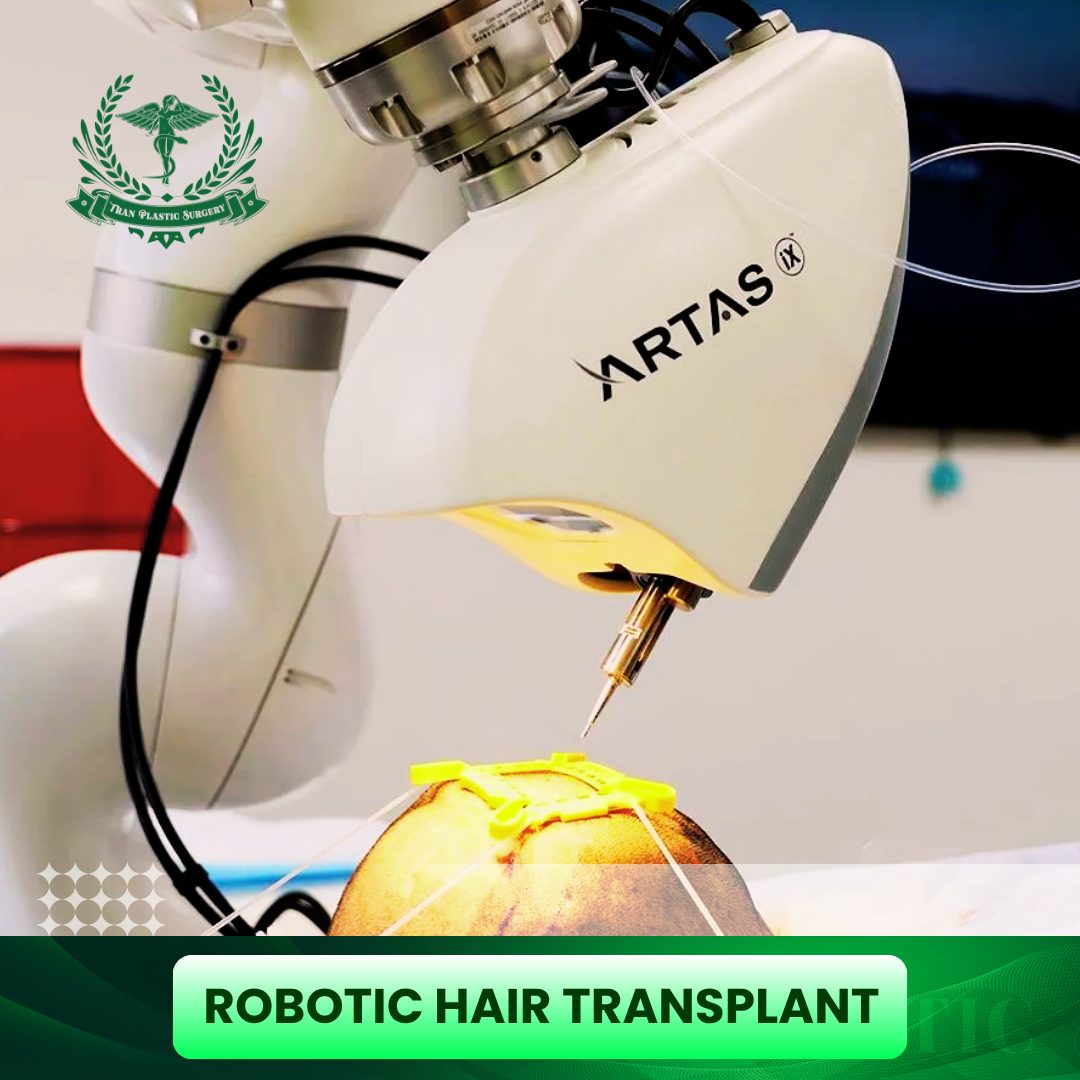Robotic hair transplant is revolutionizing the field of hair restoration, blending surgical precision with artificial intelligence to create results once thought impossible. This advanced technique uses cutting-edge robotic systems, like the ARTAS and NeoGraft platforms, to identify and extract the healthiest hair follicles with unmatched accuracy. Patients are drawn to its promise of faster recovery, minimal scarring, and a natural look that enhances confidence. Tran Plastic Surgery will explore with you how robotic hair transplant works, how it differs from traditional methods, the actual cost and why it is shaping the future of modern hair restoration.
Table of Contents
ToggleWhat Is a Robotic Hair Transplant?
A robotic hair transplant is an advanced form of hair restoration that uses artificial intelligence and robotic precision to extract and implant hair follicles with remarkable accuracy. Unlike traditional manual methods, which rely heavily on a surgeon’s hand stability and visual judgment, robotic systems such as ARTAS® and NeoGraft employ high-resolution imaging and algorithms to identify the healthiest follicles for transplantation.
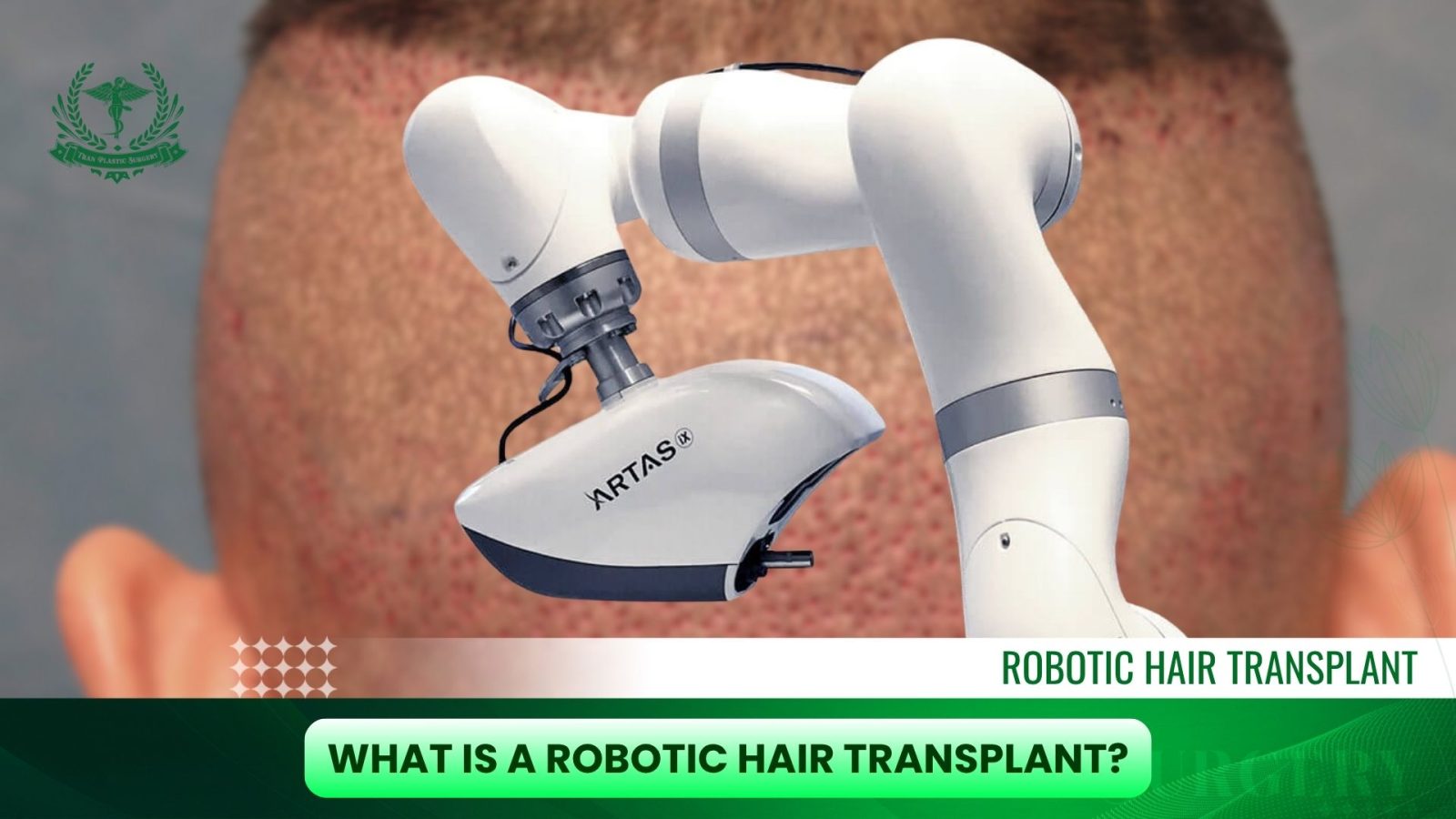
This technology enhances both efficiency and consistency, reducing the risk of human error while ensuring natural-looking results. The robotic arm performs delicate extractions with uniform precision, minimizing trauma to the donor area and improving graft survival rates. Patients benefit from shorter procedure times, minimal scarring, and a faster recovery period.
In essence, a robotic hair transplant combines human expertise with machine accuracy bringing the precision of modern engineering into aesthetic medicine. It represents a major leap forward for individuals seeking safe, predictable, and highly refined hair restoration outcomes.
>>> See the effective hair transplant method with ARTAS® IX robot at Tran Plastic Surgery center
Who Is a Good Candidate for Robotic Hair Transplant?
A robotic hair transplant isn’t right for everyone, but it’s ideal for many men and women who want a precise, minimally invasive solution. Here’s a quick overview of who benefits most:
Best Candidates
- Mild to moderate hair loss: Especially for those with thinning on the crown or receding hairlines (Norwood II–V).
- Straight or slightly wavy hair: The ARTAS robotic system performs best when follicles are easy for the robot’s imaging to detect.
- Busy professionals: Perfect for those who want minimal scarring, little downtime, and quick recovery.
- Healthy individuals: People with stable medical conditions and good scalp health.
- Previous transplant patients: Great for refining or adding density after earlier FUE or strip procedures.
Not Ideal For
- Those with very curly, light, or gray hair, which can be harder for the robot to analyze.
- People with advanced baldness or poor donor supply.
- Anyone expecting instant or overly dense results.
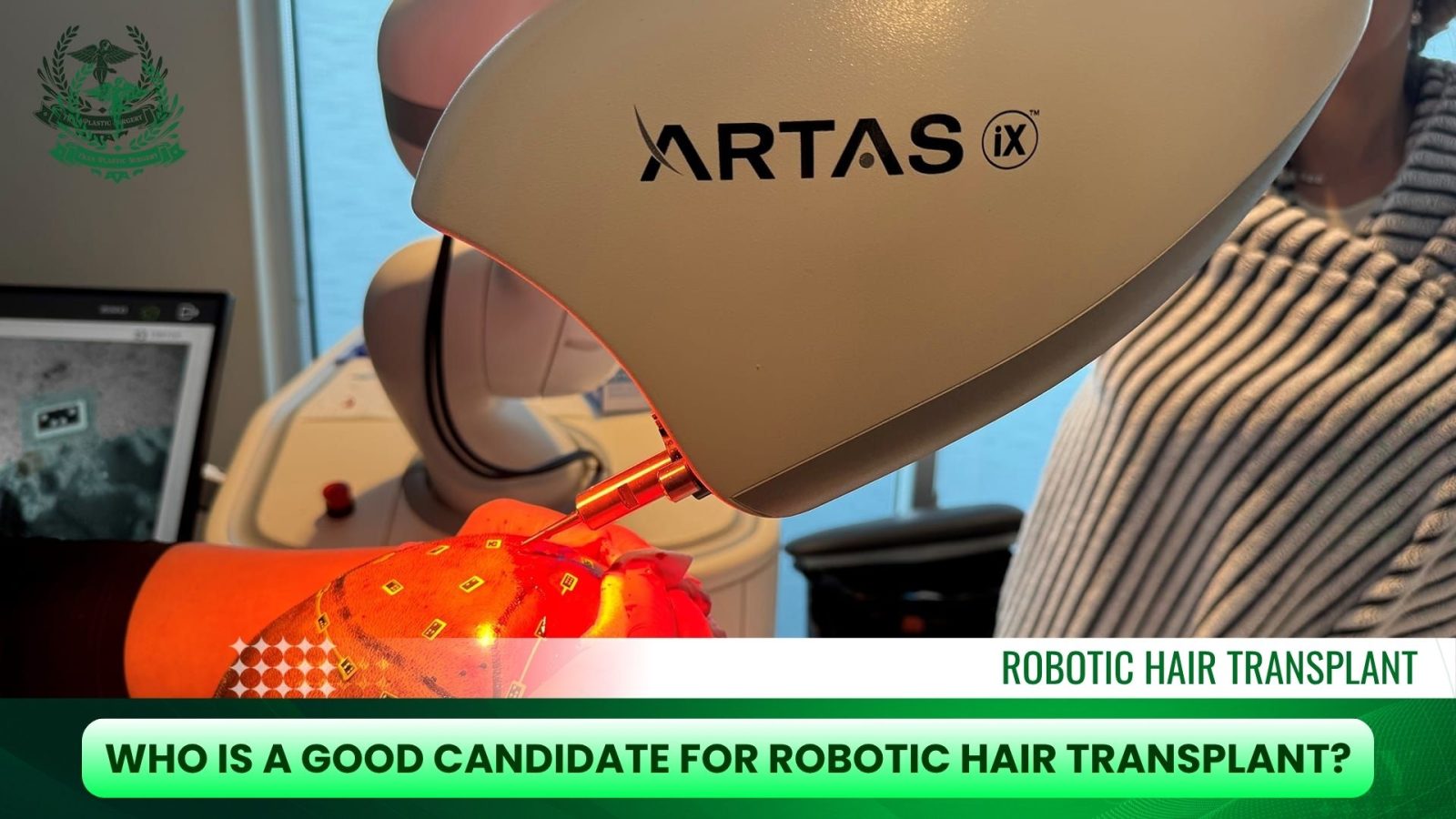
The robotic hair transplant works best for patients who want high precision, natural results, and minimal downtime. A consultation with a certified robotic surgeon is essential to confirm whether this technology suits your specific hair type and goals.
How Robotic Hair Transplant Works
A robotic hair transplant combines cutting-edge technology and surgical expertise to deliver precise, natural results. The process can be divided into three clear stages: scalp mapping, graft extraction, and implantation.
1. Scalp Mapping and Analysis
Before the procedure, the system most commonly the ARTAS robotic hair transplant system scans the scalp using high-resolution imaging. This scan creates a detailed 3D map, allowing the robot to analyze hair density, angle, and direction. With this data, it selects only the healthiest follicles for extraction, ensuring the best possible graft quality.
2. Robotic Follicle Extraction
Once the donor area is mapped, the robotic FUE hair transplant system begins removing follicles using a robotic arm guided by artificial intelligence. Each graft is extracted with uniform precision, minimizing tissue trauma and preserving surrounding follicles. The consistent pattern of extraction helps the donor area heal faster and leaves minimal visible scarring.
3. Graft Implantation and Hairline Design
After extraction, the surgeon takes over the aesthetic phase of the procedure. They design the hairline and determine the placement pattern for a natural look. The robotic system assists by maintaining consistent depth and angle when inserting each graft, ensuring even growth and long-term stability.
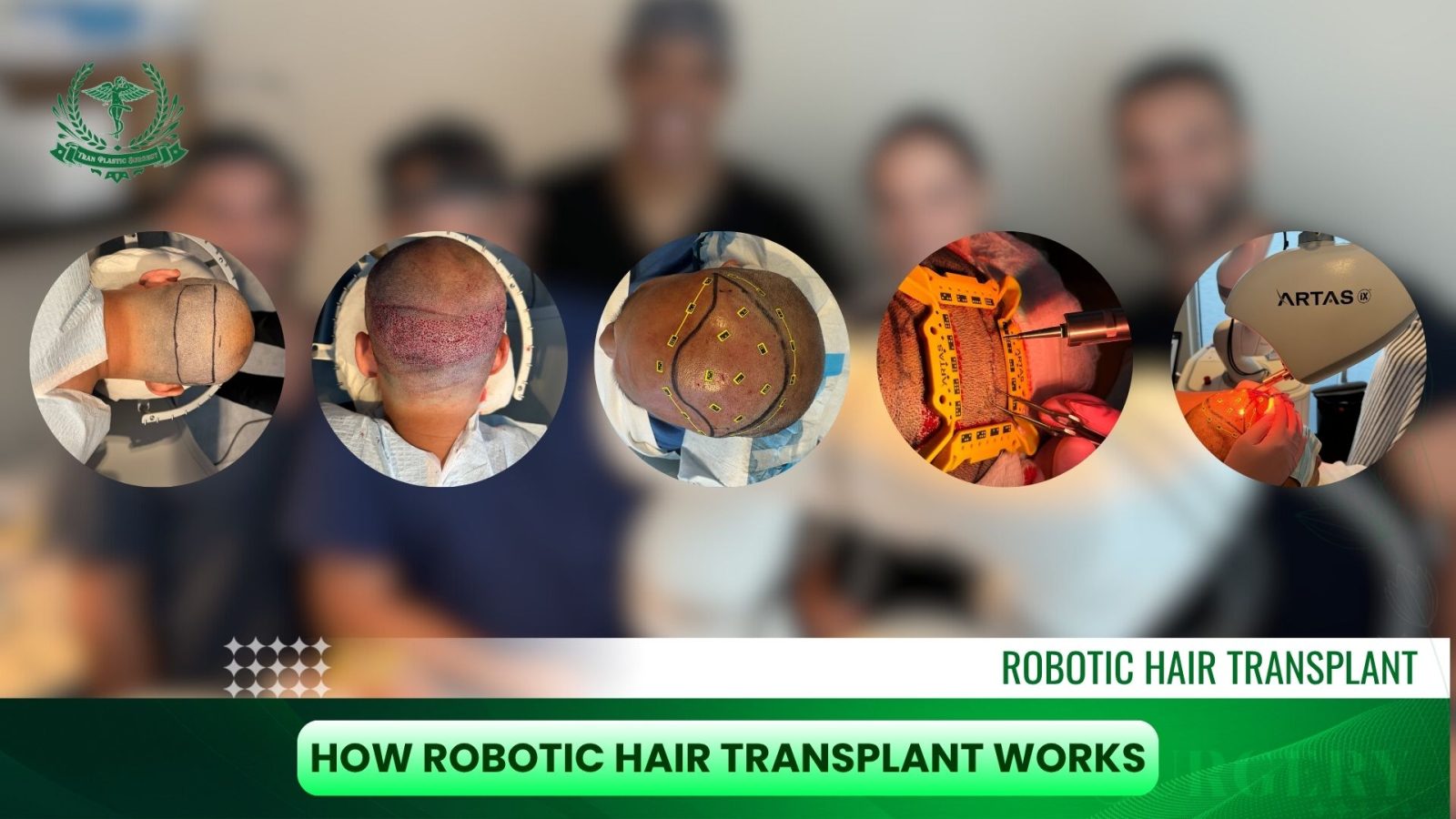
This synergy between surgeon and machine results in a highly accurate, efficient, and natural-looking outcome. The robot handles the repetitive microtasks that require mechanical precision, while the surgeon focuses on artistry, balance, and patient care. Together, they deliver a transformation that feels as authentic as it looks.
The ARTAS Robotic Hair Transplant System
The ARTAS robotic hair transplant system represents a breakthrough in hair restoration technology. It is the first FDA-approved, AI-assisted platform designed specifically for precision hair transplantation. The system combines robotic automation, real-time imaging, and artificial intelligence to deliver consistent, natural-looking results.
1. How the ARTAS System Works
Using high-definition stereoscopic cameras and advanced algorithms, the ARTAS robot scans the scalp to identify the healthiest donor follicles. Once mapped, its robotic arm performs extractions with incredible accuracy maintaining a uniform angle, depth, and spacing for each graft. This level of precision reduces the risk of follicle damage and improves overall graft survival rates.
2. Key Advantages of ARTAS Robotic
- Unmatched Precision: Each graft is harvested with consistent quality, minimizing human error.
- Minimal Scarring: The robotic arm extracts follicles evenly, leaving micro-sized incisions that heal quickly.
- Faster Recovery: Patients often return to normal activities within days, not weeks.
- Enhanced Planning: Surgeons use the ARTAS design software to visualize and plan the ideal hairline before the procedure.
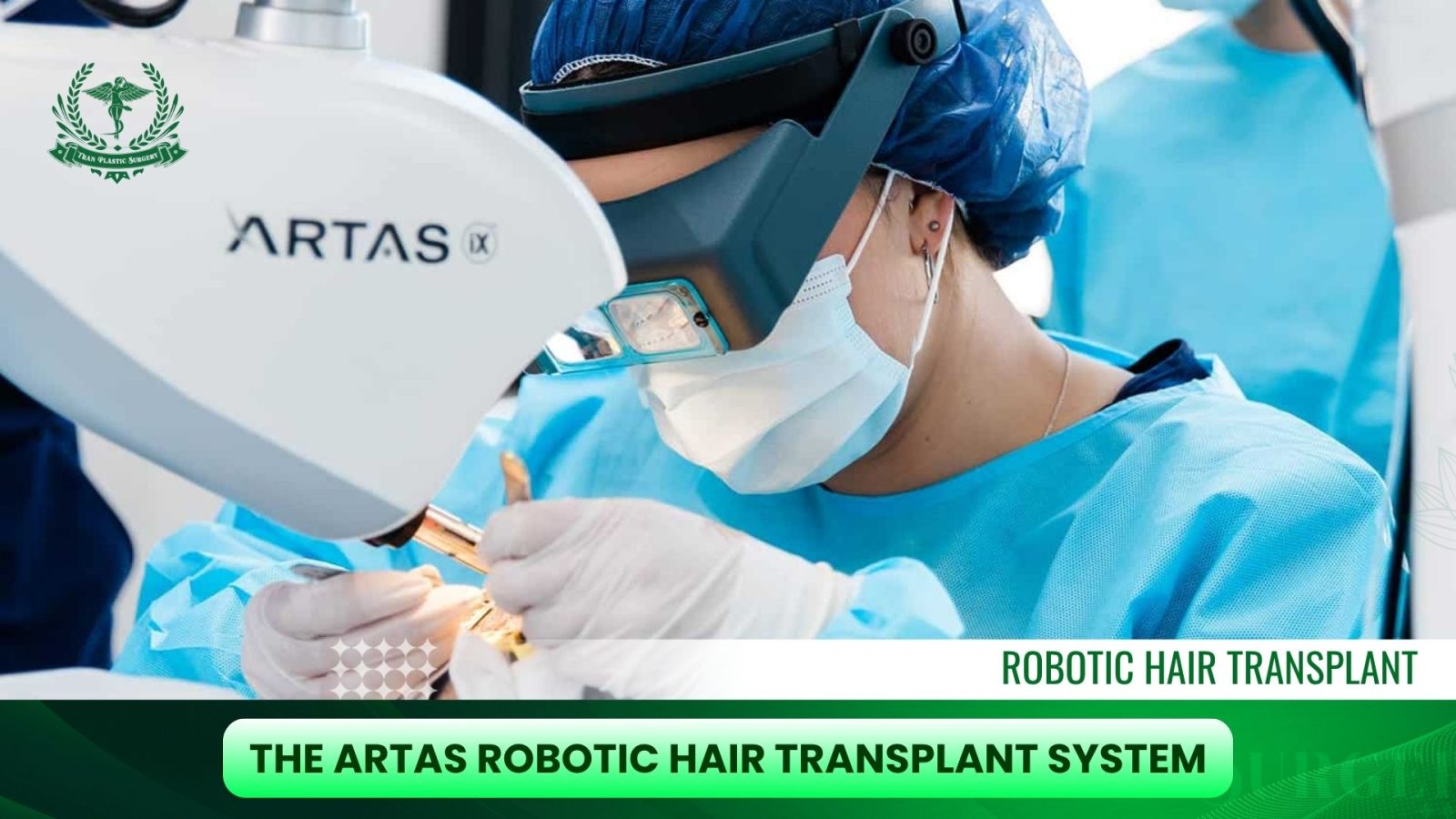
3. What Sets ARTAS Apart?
Unlike manual techniques that rely solely on a surgeon’s dexterity, the ARTAS robot maintains precision and consistency throughout the procedure even during long sessions. Its AI-guided vision system adjusts in real time to changes in scalp contour, hair angle, and density, ensuring every extraction and placement is as accurate as the first.
The result is a natural, fuller hairline with minimal downtime and predictable outcomes. For many patients, the ARTAS robotic hair transplant surgery delivers a renewed sense of confidence offering the reliability of robotics with the artistry of human expertise.
Robotic Hair Transplant Cost
The robotic hair transplant cost varies depending on several key factors, but it generally falls between $7,000 and $15,000 in the United States. This price reflects the advanced technology, surgical expertise, and precision equipment required to perform the procedure successfully.
1. Factors That Influence Cost
- Number of Grafts: The more follicles needed, the higher the cost. Clinics often charge per graft, and robotic systems typically yield a higher price per graft due to their advanced accuracy.
- Technology Used: Systems like the ARTAS robotic hair transplant involve significant investment in machinery and software updates, contributing to the higher overall treatment cost.
- Clinic Reputation and Surgeon Expertise: Clinics led by certified robotic surgeons with strong patient outcomes may charge premium rates.
- Location: Major metropolitan areas such as Los Angeles, New York, and Miami generally have higher procedure costs compared to smaller cities.
Call Tran Plastic Surgery: (714) 839-8000 – (714) 530-5888 or visit tranplastic.com to book your consultation today and discover what advanced hair restoration by robotics can do for you.
2. Comparing Robotic vs. Traditional Hair Transplant Costs
While a standard manual FUE or DHI transplant can range from $4,000 to $10,000, robotic procedures usually start at a higher baseline. However, patients often justify the additional expense due to benefits like:
- Greater precision and graft survival rate
- Reduced downtime and scarring
- More consistent, natural results
3. Understanding Value Over Price
When evaluating the hair transplant robot price, it’s important to focus on value rather than cost alone. The precision of robotic extraction minimizes wasted grafts, potentially saving future sessions. The combination of advanced imaging and consistent results means patients are more likely to achieve lasting, natural outcomes with fewer corrective procedures.
4. Financing and Payment Options
Many clinics now offer flexible payment plans, allowing patients to distribute costs over several months. This makes advanced technologies like the ARTAS robotic hair transplant more accessible to a broader audience.
While the robotic hair transplant cost is higher than traditional methods, the long-term value lies in precision, safety, and satisfaction. Patients investing in this technology are paying not only for advanced robotics but also for peace of mind knowing their results will be natural, lasting, and expertly executed.
Benefits of Robotic Hair Transplantation
A robotic hair transplant offers several advantages that distinguish it from traditional manual hair restoration methods. By combining artificial intelligence with mechanical precision, this approach delivers consistent, natural results while enhancing patient safety and comfort.
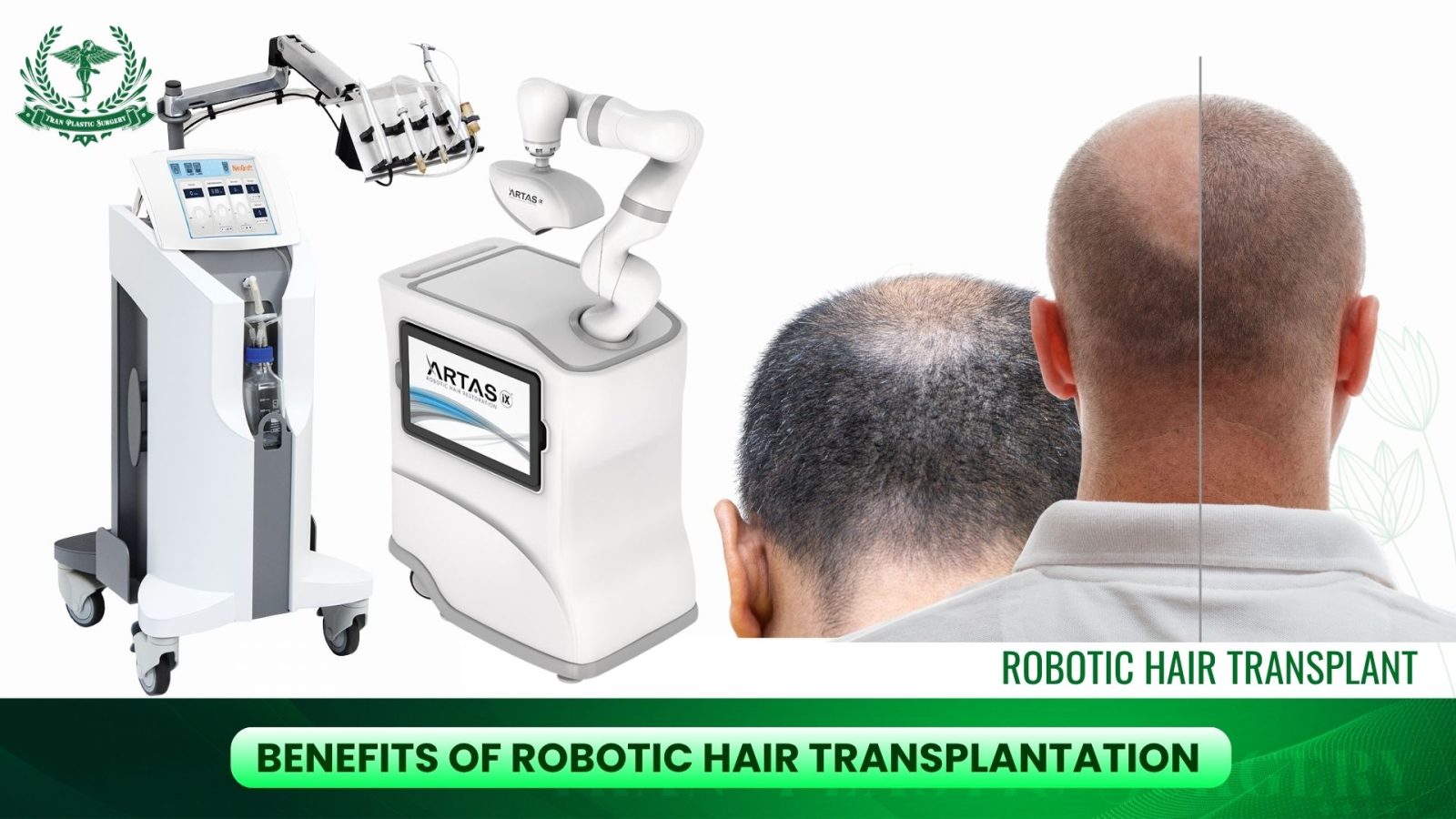
1. Superior Precision and Accuracy
The robotic system, especially the ARTAS robotic hair transplant, uses advanced imaging and algorithms to analyze every follicle before extraction. Each graft is removed at the correct depth and angle, minimizing the risk of follicle damage. This precision ensures higher graft survival rates and more natural-looking outcomes.
2. Consistent, High-Quality Results
Manual hair transplants rely heavily on the surgeon’s endurance and steady hand, which can vary over long sessions. In contrast, the robotic system maintains perfect consistency, allowing it to perform thousands of precise extractions without fatigue. This results in even density and seamless blending with existing hair.
3. Minimal Scarring and Faster Recovery
Because the robotic FUE hair transplant uses tiny, circular incisions, it leaves no linear scar unlike the traditional strip method. Most patients experience only minor redness and can return to work or daily activities within a few days.
4. Reduced Human Error
The system’s AI-guided imaging reduces guesswork, ensuring that only the healthiest follicles are chosen for transplantation. By removing human variability, robotic transplants achieve a level of reliability that manual methods struggle to match.
5. Natural Hairline Design
Surgeons use robotic software to digitally plan the placement of each graft, creating a customized and natural-looking hairline that complements the patient’s facial structure. This integration of technology and artistry sets robotic hair transplantation apart from standard FUE or DHI procedures.
6. Long-Term Hair Growth Confidence
Patients often see permanent, natural growth within 9–12 months after surgery. The precision and careful selection of follicles lead to results that not only look authentic but also age gracefully over time.
Drawbacks and Limitations of Robotic Hair Transplant
While the robotic hair transplant offers impressive precision and consistency, it also has certain drawbacks that patients should understand before making a decision. Recognizing these limitations helps set realistic expectations and ensures that the procedure is the right fit for each individual.
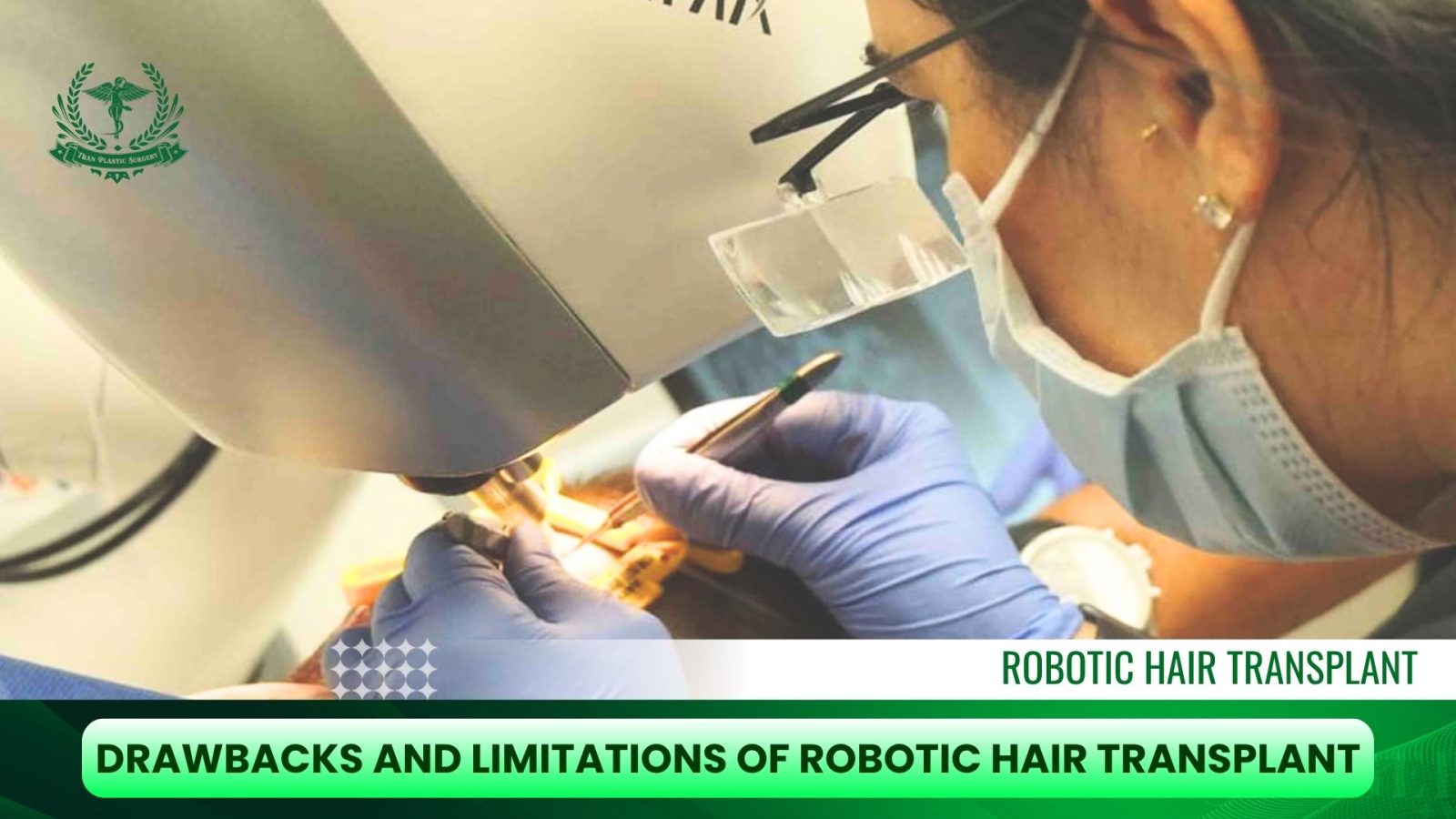
1. Higher Cost
One of the primary disadvantages of this procedure is its cost. The robotic hair transplant cost is typically higher than traditional FUE or DHI methods due to the advanced technology and equipment involved. Clinics must invest heavily in machines like the ARTAS robotic hair transplant system, and this investment is reflected in the overall treatment price.
2. Limited Candidate Suitability
Not everyone is an ideal candidate for robotic transplantation. The system performs best on patients with straight or slightly wavy dark hair, as the imaging software can more easily detect follicle angles and density. Those with very curly, light, or gray hair may not achieve optimal results because the robot can have difficulty recognizing individual follicles.
3. Dependence on Technology
The procedure relies heavily on machine accuracy. While robotic systems are incredibly precise, they still require continuous calibration and expert supervision. If a clinic lacks experienced surgeons trained in robotic systems, results may not reach their full potential.
4. Longer Setup Time
Robotic systems require detailed mapping and preparation before the actual extraction begins. Although the extraction phase is faster, the overall setup can take longer than expected. This makes the process more time-intensive for both patients and clinics.
5. Availability and Accessibility
Not every hair restoration clinic offers robotic procedures, and access may be limited in smaller cities or countries. This makes it less convenient for patients who prefer in-person consultations and local aftercare.
6. Learning Curve for Surgeons
Even though the technology assists with precision, surgeons still need specialized training to operate and interpret the robotic system effectively. Clinics with limited experience may struggle to maintain consistency or deliver the desired aesthetic results.
In conclusion, while robotic technology brings automation, precision, and innovation to hair restoration, it isn’t a universal solution. Patients should weigh the benefits and limitations carefully, consult with certified professionals, and ensure their chosen clinic has proven expertise in ARTAS robotic hair transplant surgery.
Comparison Robotic Hair Transplant vs. Traditional Hair Transplant Methods
| Feature | Robotic Hair Transplant (ARTAS, NeoGraft) | Manual FUE / DHI (Traditional Methods) | FUT (Strip Surgery) |
| Technology | AI-guided robotic arm with digital scalp mapping | Manual handheld extraction tools | Scalpel strip removal technique |
| Precision | Extremely high; robot analyzes angle, depth, and spacing automatically | High, depends on surgeon’s skill and endurance | Moderate; larger grafts, less precision |
| Scarring | Minimal micro-scars, no linear marks | Small puncture scars, typically fade | Linear scar at donor site |
| Comfort Level | Very comfortable; local anesthesia and minimal trauma | Comfortable; slightly more manual handling | More invasive and painful recovery |
| Recovery Time | Fast (3–5 days) | Moderate (5–7 days) | Longer (10–14 days) |
| Consistency | Excellent; automation ensures uniform grafts | Varies with surgeon’s experience | Consistent but limited by human control |
| Customization | Digital hairline design tools, surgeon-guided | Full manual customization | Limited; fixed graft sizes |
| Speed | Fast extraction; ideal for large sessions | Moderate, depends on team size | Fast removal but longer healing |
| Graft Survival Rate | ~82–90% (based on clinical data) | ~90–97% (expert surgeons) | ~85–90% |
| Cost Range (U.S.) | $7,000 – $15,000 | $4,000 – $10,000 | $3,000 – $8,000 |
| Best For | Patients seeking precision, minimal downtime, advanced tech | Those preferring personalized artistry and cost-efficiency | Patients needing large graft numbers at lower cost |
| Main Limitation | Higher cost, limited for very curly or light hair | Fatigue or human error in long sessions | Visible scarring and longer healing |
| Overall Rating | ⭐⭐⭐⭐⭐ (Best precision and comfort) | ⭐⭐⭐⭐☆ (Most versatile) | ⭐⭐⭐☆☆ (Cost-effective but outdated) |
* Note that the comparison table above is for reference only. For exact information on each method, please contact your trusted plastic surgery center.
Robotic Hair Transplant Reviews and Patient Experience
Real-world experiences and clinical data provide valuable insight into how effective and reliable a robotic hair transplant truly is. Patient feedback from reputable sources, along with medical studies, helps separate marketing claims from practical results.
1. Real Patient Feedback
On RealSelf, more than 90% of reviewers rated the ARTAS robotic hair transplant as “Worth It.” Patients consistently praise the procedure’s accuracy, comfort, and natural results.
“Cannot express how pleased I am with my result … looks natural and undetectable.” – RealSelf patient review
“It was virtually painless, no scar, no stitches. I was back at work in three days.” – Verified RealSelf reviewer, Palo Alto
One user who had previously undergone manual strip procedures shared:
“Compared to strip, the robot was a walk in the park. The recovery was smooth, and the donor area healed fast.” – RealSelf patient review
However, not all experiences are positive. On Reddit, one user warned:
“ARTAS sucks. Massive transection rate. At least 20% of grafts are damaged during extraction.”
This illustrates that results can vary depending on the clinic, the system’s calibration, and the surgeon’s oversight.
2. Expert and Clinical Perspectives
Clinical research supports much of the positive feedback while also providing a balanced view. A 2024 comparative study published in JCAD found:
- Graft survival: robotic ~82% vs. manual FUE ~90%
- Transection rate: similar between both methods (~13%)
- Patient satisfaction: comparable in both groups
(Source: National Center for Biotechnology Information – PMC11626372)
Additionally, data from Bernstein Medical show that the ARTAS algorithm tends to harvest grafts containing more hairs per unit on average, potentially increasing density in fewer sessions.
Some surgeons remain cautious, noting that robotic systems may deliver slightly lower graft yield than top-tier manual FUE experts. Clinics like Hair Doctor Florida report manual survivability rates of 95–97% versus about 90% for robotic procedures.
*Notes:
- Most verified patients describe the experience as comfortable, fast-healing, and natural in appearance.
- Clinical studies confirm competitive graft survival and safety, though not always superior to expert manual FUE.
- Success heavily depends on surgeon expertise and system calibration technology enhances skill, not replaces it.
- Transparency in pricing, surgeon experience, and patient education remains crucial for realistic expectations.
Robotic Hair Transplant Near Me – California’s Leading Options
If you’re considering a robotic hair transplant near me in California, you’re in one of the best places in the country to experience this cutting-edge technology. The state is home to several clinics that specialize in advanced robotic systems, including the latest ARTAS® IX platform designed for speed, precision, and natural results.
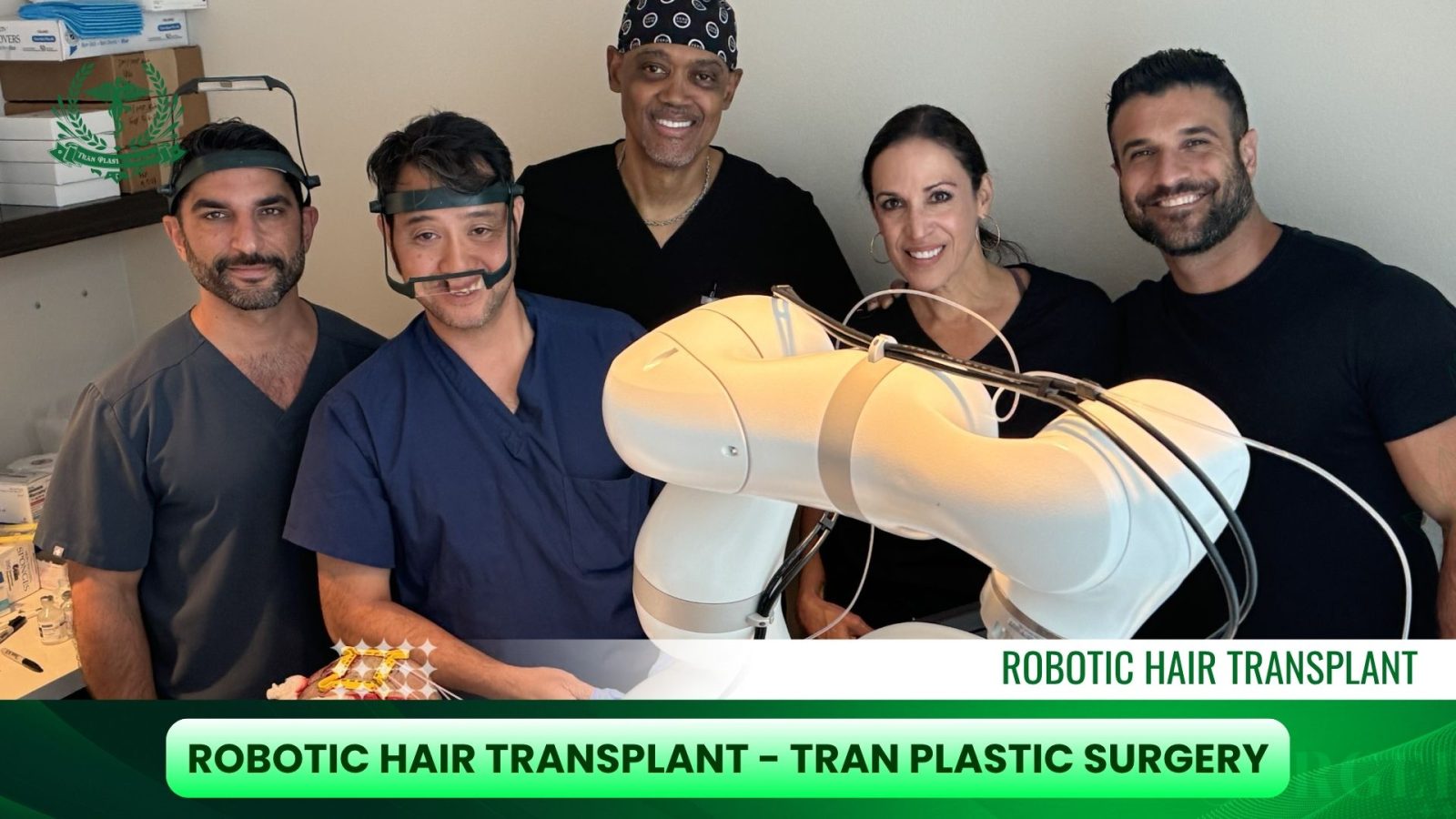
Tran Plastic Surgery – Precision with ARTAS® IX
One of California’s top destinations for robotic hair restoration is Tran Plastic Surgery, where Dr. Tran performs procedures using the state-of-the-art ARTAS® IX system.
This advanced technology uses artificial intelligence and robotic precision to extract and implant hair follicles with incredible accuracy, helping patients achieve natural density and improved graft survival. Tran Plastic Surgery is known for blending aesthetic artistry with advanced technology, ensuring every patient receives personalized treatment and long-lasting results.
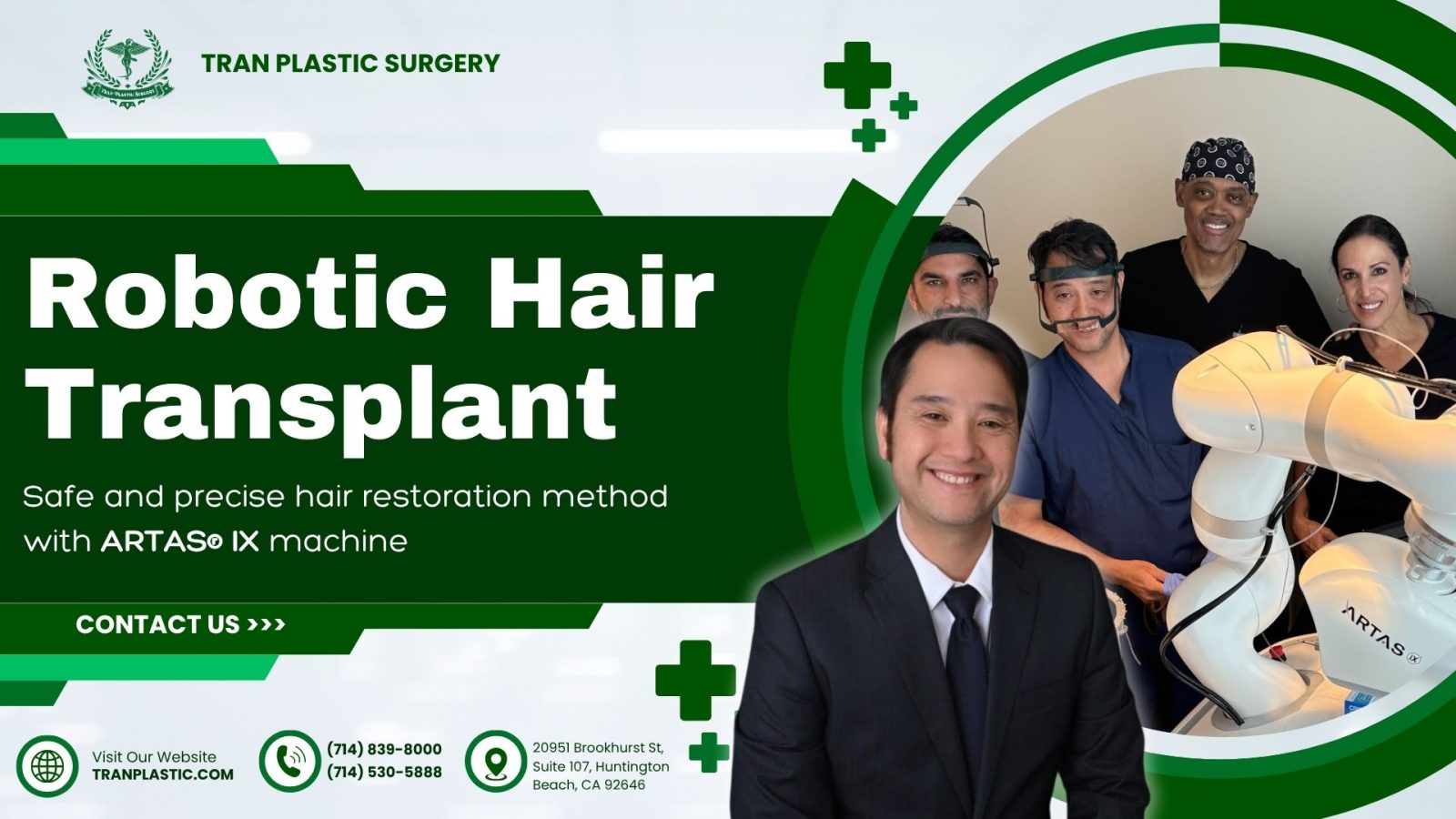
*Read more:
- Hair Transplant And Medical Treatment For Hair Growth
- Hair Restoration Surgery: Techniques, Costs & Results Explained
Aftercare and Recovery After a Robotic Hair Transplant
Recovery from a robotic hair transplant especially with systems like ARTAS® IX is usually quick and simple.
- First few days: Expect mild redness and swelling; avoid touching or scratching your scalp.
- Washing: Gently wash your hair after 2–3 days with mild shampoo and pat dry.
- Activities: Avoid workouts, swimming, and direct sunlight for about a week.
- Healing: Transplanted hairs may shed within the first month; new growth appears around 3–4 months and fully matures by 9–12 months.
- Follow-up: Keep post-op appointments and follow your surgeon’s care plan for lasting results.
A robotic hair transplant offers an easy recovery and long-term, natural results when proper aftercare is followed.
Future of Hair Restoration – Robotic and AI Innovations
The future of hair restoration is being shaped by artificial intelligence, robotics, and precision imaging. Modern systems like ARTAS® IX have already set new standards for accuracy, but the next generation of technologies promises even more advanced results.
- Smarter AI and Predictive Planning: AI algorithms are evolving to analyze scalp patterns, predict future hair loss, and design custom restoration maps that ensure balanced, natural density. This allows for better long-term planning and more stable results.
- Fully Automated Transplant Systems: Emerging research points toward next-gen robotic systems that can handle both extraction and implantation autonomously, reducing surgery time and human fatigue while maintaining perfect precision.
- Integration with Regenerative Medicine: Combining robotics with PRP (Platelet-Rich Plasma) and stem cell therapies is showing promise for faster healing and improved follicle survival.
- Virtual Consultations and Digital Mapping: AI-driven scalp scanning and virtual consultations will make treatments more accessible, allowing patients to visualize their results before surgery through 3D imaging and simulation software.
FAQs About Robotic Hair Transplant
1. Is a robotic hair transplant better than manual FUE?
Both methods can achieve excellent results. The robotic system offers greater consistency and faster extraction, while manual FUE (Follicular Unit Extraction) allows for more artistic customization. The best option depends on your goals and your surgeon’s expertise.
2. Is robotic hair transplant safe?
Yes. The ARTAS robotic hair transplant is FDA-cleared and has been clinically proven to be safe and effective. As with any procedure, results depend on the surgeon’s experience and adherence to proper aftercare.
3. Can women have a robotic hair transplant?
Yes. Women with localized thinning or pattern hair loss can benefit from robotic transplants, provided they have enough donor hair and meet other medical requirements.
4. How Are ARTAS® Results Different From Old “Hair Plugs”?
The ARTAS® robotic hair transplant uses precise follicle-by-follicle extraction, creating smooth, natural results without visible scarring. Old “hair plugs” used large grafts, which looked clumpy and unnatural. ARTAS® restores hair with refined density and direction for a seamless appearance.
5. Do I Have to Cut My Hair Before Treatment?
Yes, the donor area usually needs to be trimmed short (about 1 mm) so the ARTAS® IX system can accurately identify and extract follicles. In some cases, only small sections are trimmed to keep the rest of your hair intact.

